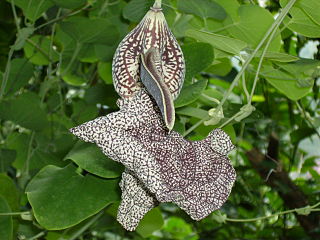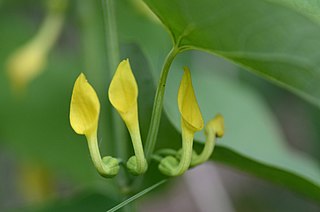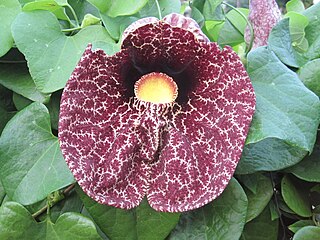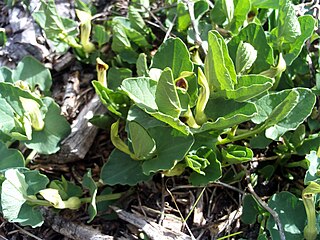
Ayahuasca is a South American psychoactive and entheogenic brewed drink traditionally used both socially and as a ceremonial or shamanic spiritual medicine among the indigenous peoples of the Amazon basin, and more recently in North America and Europe. The infusion causes altered states of consciousness often known as "psychedelic experiences" which include visual hallucinations and altered perceptions of reality.

The Aristolochiaceae are a family, the birthwort family, of flowering plants with seven genera and about 400 known species belonging to the order Piperales. The type genus is Aristolochia L.

Aristolochic acids are a family of carcinogenic, mutagenic, and nephrotoxic phytochemicals commonly found in the flowering plant family Aristolochiaceae (birthworts). Aristolochic acid (AA) I is the most abundant one. The family Aristolochiaceae includes the genera Aristolochia and Asarum, which are commonly used in Chinese herbal medicine. Although these compounds are widely associated with kidney problems, liver and urothelial cancers, the use of AA-containing plants for medicinal purposes has a long history. The FDA has issued warnings regarding consumption of AA-containing supplements.

Asarum is a genus of plants in the birthwort family Aristolochiaceae, commonly known as wild ginger.

Aristolochia is a large plant genus with over 500 species that is the type genus of the family Aristolochiaceae. Its members are commonly known as birthwort, pipevine or Dutchman's pipe and are widespread and occur in the most diverse climates. Some species, like A. utriformis and A. westlandii, are threatened with extinction.

Aristolochia californica, the California pipevine, California Dutchman's-pipe, or California snakeroot is a perennial woody vine of western North America.

Battus philenor, the pipevine swallowtail or blue swallowtail, is a swallowtail butterfly found in North America and Central America. This butterfly is black with iridescent-blue hindwings. They are found in many different habitats, but are most commonly found in forests. Caterpillars are often black or red, and feed on compatible plants of the genus Aristolochia. They are known for sequestering acids from the plants they feed on in order to defend themselves from predators by being poisonous when consumed. The adults feed on the nectar of a variety of flowers. Some species of Aristolochia are toxic to the larvae, typically tropical varieties. While enthusiasts have led citizen efforts to conserve pipevine swallowtails in their neighborhoods on the West coast, the butterfly has not been the subject of a formal program in conservation or protected in legislation. The butterfly is however of "Special Concern" in Michigan, which is on the Northern limit of its range.

Balkan endemic nephropathy (BEN) is a form of interstitial nephritis causing kidney failure. It was first identified in the 1920s among several small, discrete communities along the Danube River and its major tributaries, in the modern countries of Croatia, Bosnia and Herzegovina, Serbia, Kosovo, Romania, and Bulgaria. It is caused by small long-term doses of aristolochic acid in the diet. The disease primarily affects people 30 to 60 years of age. Doses of the toxin are usually low and people moving to endemic areas typically develop the condition only when they have lived there for 10–20 years. People taking higher doses of aristolochic acid have developed kidney failure after shorter durations of exposure.

Aristolochia clematitis, the (European) birthwort, is a twining herbaceous plant in the family Aristolochiaceae, which is native to Europe. The leaves are heart shaped and the flowers are pale yellow and tubular in form. The plant seeks light by ascending the stems of surrounding plants.

Aristolochia littoralis, the calico flower or مورپنکھ بیل or elegant Dutchman's pipe, is a species of evergreen vine belonging to the family Aristolochiaceae.

Aristolochia rotunda, commonly known as smearwort or round-leaved birthwort, is a herbaceous perennial plant native to Southern Europe.

Stephania is a genus of flowering plants in the family Menispermaceae, native to eastern and southern Asia and Australia. They are herbaceous perennial vines, growing to around four metres tall, with a large tuber. The leaves are arranged spirally on the stem and are peltate, with the leaf petiole attached near the centre of the leaf. The name Stephania comes from the Greek, "a crown". This refers to the anthers being arranged in a crown-like manner.

Asarum canadense, commonly known as Canada wild ginger, Canadian snakeroot, and broad-leaved asarabacca, is a herbaceous, perennial plant which forms dense colonies in the understory of deciduous forests throughout its native range in eastern North America, from the Great Plains east to the Atlantic Coast, and from southeastern Canada south to around the Fall Line in the southeastern United States.
Stephania tetrandra is a herbaceous perennial vine of the family Menispermaceae native to China and Taiwan. It grows from a short, woody caudex, climbing to a height of around three meters. The leaves are arranged spirally on the stem, and are peltate, i.e. with the leaf petiole attached near the centre of the leaf. Its root is used in traditional Chinese medicine (TCM).

Aristolochia grandiflora, the pelican flower, is a deciduous vine with one of the world's largest flowers that emits an odor that smells like rotting meat, attracting flies.

Aristolochia indica is a creeper plant found in Southern India and also Sri Lanka. It Is known as 'sapsada' in Sri Lanka and is critical to the survival of the southern birdwing and common birdwing, as well as crimson and common rose butterflies. It reaches a height of several metres on trees and cover the branches with thick foliage. It is commonly found in forest floor, rocky hillslopes. It flowers once a year to produce seeds. It can also be propagated by roots. The plant has a number of historical medicinal uses.

Orbexilum pedunculatum, commonly known as Sampson's snakeroot, is a species of flowering plant in the legume family. It is native primarily to the Southeastern United States where it is found in prairies and savannas, often in acidic soil. It is a perennial that produces racemes of flowers in early summer.

Aristolochia paucinervis is a herbaceous plant in the family Aristolochiaceae endemic to the western Mediterranean Basin.
Aristolochia fangchi, is a species of flowering plant in the family Aristolochiaceae, native to Vietnam and southeast and south-central China.

















